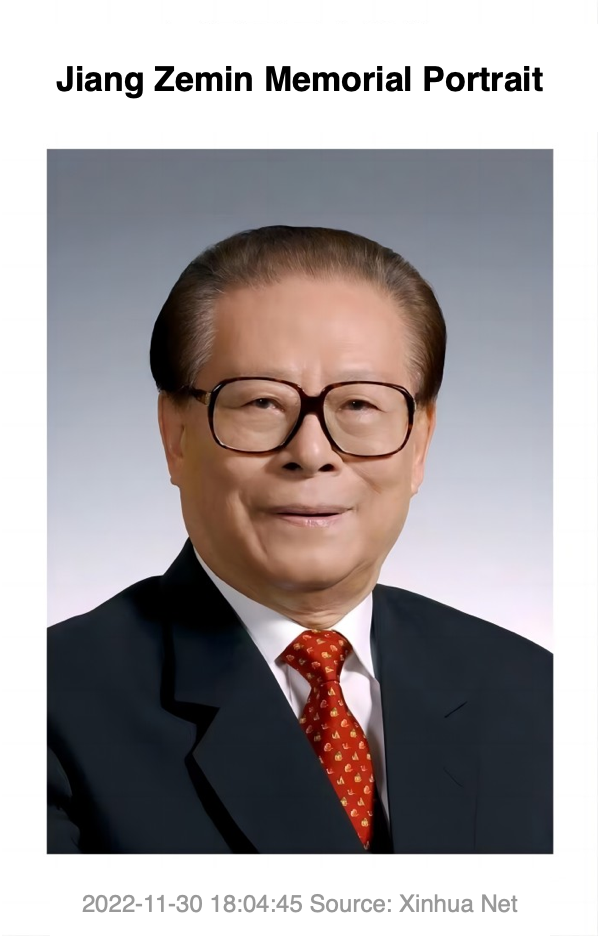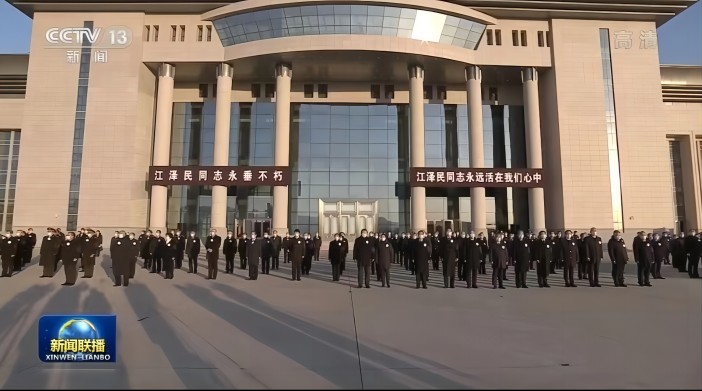


Ceremony
A flag flown at half-mast is used to show mourning around the world, and in China the standards for a half-mast ceremony are particularly high. Article 15 of the National Flag Law of the People’s Republic of China stipulates: In accordance with the provisions of this Article, the dates and locations where the flag will be flown at half-mast are to be determined by a state-organized funeral committee or by the State Council.
Following the death of the esteemed Jiang Zemin, China determined that locations where the flag will be flown at half-mast fall within two ranges depending on the location’s importance.
Announcement No. 1 from the Jiang Zemin Funeral Committee:
To express all of China’s unparalleled respect for Comrade Jiang Zemin and our profound sense of loss at his passing, it is hereby decided: From the release date of the official government death notification to the date of the state funeral, Tian’anmen, Xinhua Gate, the Great Hall of the People, and the Ministry of Foreign Affairs in Beijing, as well as the liaison offices in Hong Kong and Macao and Chinese embassies and consulates abroad, will fly the national flag at half-mast to mark Jiang Zemin’s passing.
The important locations where the flag must be flown at half-mast at this time were decided by this announcement. The flag must be flown at half-mast at several locations in Beijing and at diplomatic missions abroad from November 30 to the date of Jiang Zemin’s funeral on December 6, 2022.
During this period, the flag should not be flown at half-mast anywhere else, such as workplaces or schools. Some schools are already flying the flag at half-mast, and while their frame of mind is understandable, they should comply with the relevant laws and not act under their own authority.
Announcement No. 2 from the Jiang Zemin Funeral Committee:
In view of Comrade Jiang Zemin’s exceptional contributions to the development of Party and State and per the shared wishes of all of China, it is hereby decided:
On the date of Jiang Zemin’s state funeral, the national flag will be flown at half-mast across China and at China’s embassies, consulates, and other agencies stationed abroad. Public entertainment activities will be suspended for the day. At the time of the funeral, people across the country will observe 3 minutes of silence while horns and whistles are blown and civil defense sirens sound.
On December 6, the flag will be flown at half-mast nationwide and at diplomatic missions outside of China. The announcement also mentions united displays of mourning that will occur all over China.
A nationwide half-mast ceremony is an extraordinary and major event, and the ceremony must be conducted with dignity and with respect to the laws and regulations. The main requirements of the half-mast ceremony are as follows:
1. When Raising the Flag
The flag should be raised at the usual time. The flag in Tiananmen Square is raised at sunrise. Other locations required to display the flag, such as all levels of Party, government, and military organizations, all democratic parties and people's organizations, schools, public cultural and sports facilities, and village and residential committees, should raise the flag in the early morning or during working hours. On the morning of the state funeral in Beijing, it is inadvisable to raise the flag at 10 a.m.
2. Replacement of the Flag
On December 6, the date of the nationwide half-mast ceremony, it is especially necessary to use a new flag. Damaged, soiled, faded, or nonstandard flags cannot be displayed.
3. The Half-Mast Ceremony
The chief leader of an organization is encouraged to personally raise and lower the flag to half-mast, to preside over the half-mast ceremony, or to give the commands for the flag to be raised and then lowered to half-mast. Whether the organization leader gives the commands or personally raises the flag, it is imperative to run a sincere and stringent drill in person and in advance. Do not throw caution to the wind on the day of the ceremony itself. Otherwise, it is likely that missed details and discoordination will negatively impact the ceremony.
National flag law requires that for a half-mast ceremony, the flag should first be raised to the top of the pole, then lowered so that the distance between the top of the pole and the top of the flag is a third of the flagpole’s total length. While the flag is being raised, the national anthem must be played; the anthem can be broadcast through speakers or performed by a band. No music plays while the flag is lowered to half-mast. If the flag is raised by hand, ensure the flag matches the tempo of the music so that the flag reaches the top of the pole as the anthem concludes.
During the flag-raising ceremony, be very careful so the corners of the flag do not touch the ground. After the flag is at half-mast and depending on the circumstances, an address can be given from under the flag.
When it is time for the flag-lowering ceremony in the evening, the flag should first be raised to the top of the pole and then lowered back down. Take care that the flag is raised and lowered at the same speed, and do not perform the anthem while lowering the flag.
4. Drill Commands for the Half-Mast Ceremony
While raising the flag, troop formations and scope will differ depending on where the ceremony takes place. The host of the ceremony, the highest-ranking leader, or the flag squad leader will give the commands to hoist the flag, perform the anthem, and salute; once the anthem has finished and the flag has reached the top of the pole, they say “at ease,” then immediately give the command to “Lower the flag to half-mast and salute.” Once the flag sits two-thirds of the way up the pole, they say “at ease.”
When it is time for the flag-lowering ceremony in the evening, depending on the number of troops present, either the squad leader or the flag carrier can give the commands to raise the flag and salute, raise the flag to the top of the pole, and the command “at ease.” They should then immediately give the command to “Lower the flag and salute.”
When ordered to salute, all military, police, and uniformed groups in attendance must comply. Young Pioneers of China perform their own salute. All others should stand respectfully at attention.

During Jiang Zemin’s time as general secretary, China refined its national flag laws and standardized the flag-raising ceremony. The National Flag Law of the People’s Republic of China was issued in 1990 and the National Emblem Law was issued in 1991. In 1991, Tiananmen Square was refurbished with a new flagpole and pedestal, and the 3-person flag team in charge of the flag-raising ceremony was expanded into a color guard of 36. In 1991, the national criteria for the design and color of the flag were issued, and in 2001, the national standards for flagpoles were issued.
The esteemed Jiang Zemin will never be forgotten!
Zhao Xinfeng
Chief Drill Instructor of School Flag-Bearers at the National Level
1st Squad Leader of the Tiananmen Square 36-Person Color Guard
December 2, 2022; Beijing
英文翻译:志愿者 潘思婷
Powered by Redyue